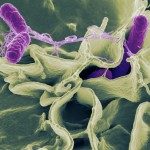Link to Pubmed [PMID] – 32430292
Link to DOI – eaaw890510.1126/scisignal.aaw8905
Sci Signal 2020 05; 13(632):
In nature, bacteria form biofilms-differentiated multicellular communities attached to surfaces. Within these generally sessile biofilms, a subset of cells continues to express motility genes. We found that this subpopulation enabled Bacillus subtilis biofilms to expand on high-friction surfaces. The extracellular matrix (ECM) protein TasA was required for the expression of flagellar genes. In addition to its structural role as an adhesive fiber for cell attachment, TasA acted as a developmental signal stimulating a subset of biofilm cells to revert to a motile phenotype. Transcriptomic analysis revealed that TasA stimulated the expression of a specific subset of genes whose products promote motility and repress ECM production. Spontaneous suppressor mutations that restored motility in the absence of TasA revealed that activation of the biofilm-motility switch by the two-component system CssR/CssS antagonized the TasA-mediated reversion to motility in biofilm cells. Our results suggest that although mostly sessile, biofilms retain a degree of motility by actively maintaining a motile subpopulation.


